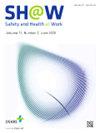Impact of Earned Sick Leave Policy on Worker Wellbeing Across Industries
IF 2.9
3区 医学
Q1 PUBLIC, ENVIRONMENTAL & OCCUPATIONAL HEALTH
引用次数: 0
Abstract
Background
Earned sick leave (ESL) policies enable employees to have paid time off to address short-term, individual, or familial health needs. In the U.S., ESL is not federally mandated, but state ESL adoption has increased. Despite this increase, if and how ESL policies impact nonfatal illness/injury reporting by workers remain unknown.
Methods
Average treatment effect on the treated estimates of ESL policies were reached using two-way fixed effects and Gardner's two-stage difference-in-differences approach. Annual state rates of occupational nonfatal illness/injury reports were derived from the Bureau of Labor Statistics for each North American Industry Classification. ESL policy data were accessed from Temple University Center for Public Health Law Research's Law Atlas.
Results
In states that adopted ESL prior to 2019, two-way fixed effect analyses suggest a marginally significant increase in rates of nonfatal illness/injury reports across industries (+0.064 cases per 100 full-time workers, p = 0.10) following the implementation of ESL policies. Industries with low proportions of insured employees did not experience a change in reported illness/injury following ESL policy adoption. Industries with high proportions of employees with known barriers to care also experienced no change in reported illness/injury post ESL adoption.
Conclusion
ESL policy enactment is a promising strategy for improving worker wellbeing by encouraging reporting to employers and foreseeably increasing use of time off for illness/injury recovery. However, results also suggest ESL policies do not benefit all employees to the same extent.
带薪病假政策对各行业工人福利的影响
带薪病假(ESL)政策使员工能够有带薪休假来解决短期、个人或家庭健康需求。在美国,ESL并不是联邦强制要求的,但是各州对ESL的采用有所增加。尽管这种增长,ESL政策是否以及如何影响工人的非致命性疾病/伤害报告仍然未知。方法采用双向固定效应和Gardner的两阶段差中差法对ESL政策的处理估计达到平均处理效果。职业非致命疾病/伤害报告的年度州率来自劳工统计局的每个北美行业分类。ESL政策数据来自天普大学公共卫生法研究中心的法律地图集。在2019年之前采用ESL的州,双向固定效应分析表明,在实施ESL政策后,各行业的非致命性疾病/伤害报告率略有显著增加(每100名全职工人+0.064例,p = 0.10)。保险员工比例低的行业在采用ESL政策后,报告的疾病/受伤情况没有变化。在那些有较高比例的员工在护理方面存在障碍的行业中,采用ESL后报告的疾病/受伤情况也没有变化。esl政策的制定是一项有希望的策略,通过鼓励员工向雇主报告,并可预见地增加病假/伤病康复的使用,可以改善员工的福利。然而,结果也表明,ESL政策并不是对所有员工都有同样的好处。
本文章由计算机程序翻译,如有差异,请以英文原文为准。
求助全文
约1分钟内获得全文
求助全文
来源期刊

Safety and Health at Work
Social Sciences-Safety Research
CiteScore
6.40
自引率
5.70%
发文量
1080
审稿时长
38 days
期刊介绍:
Safety and Health at Work (SH@W) is an international, peer-reviewed, interdisciplinary journal published quarterly in English beginning in 2010. The journal is aimed at providing grounds for the exchange of ideas and data developed through research experience in the broad field of occupational health and safety. Articles may deal with scientific research to improve workers'' health and safety by eliminating occupational accidents and diseases, pursuing a better working life, and creating a safe and comfortable working environment. The journal focuses primarily on original articles across the whole scope of occupational health and safety, but also welcomes up-to-date review papers and short communications and commentaries on urgent issues and case studies on unique epidemiological survey, methods of accident investigation, and analysis. High priority will be given to articles on occupational epidemiology, medicine, hygiene, toxicology, nursing and health services, work safety, ergonomics, work organization, engineering of safety (mechanical, electrical, chemical, and construction), safety management and policy, and studies related to economic evaluation and its social policy and organizational aspects. Its abbreviated title is Saf Health Work.
 求助内容:
求助内容: 应助结果提醒方式:
应助结果提醒方式:


